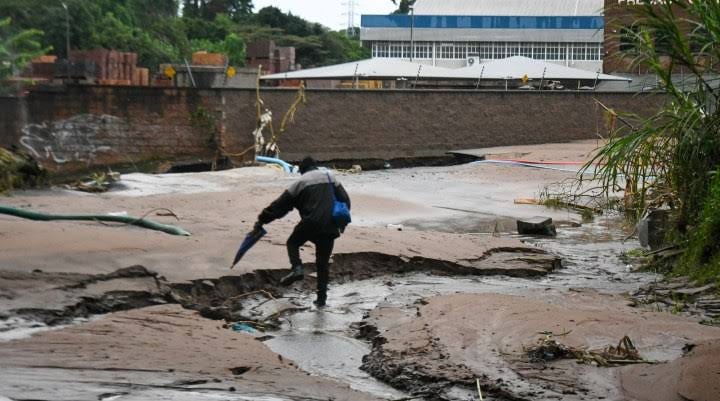We asked an expert why Durban floods so often
What does climate change have to do with it, and how can we improve this?
By Zoe Thomas
Durban, South Africa – Disruptive rain has persistently affected KwaZulu-Natal residents with regular flooding across Durban, resulting in enormous destruction and loss to lives.
Heavy rainfall has left parts of KwaZulu-Natal devastated, as severe flooding wreaked havoc across the region, displacing thousands and causing extensive damage to homes, businesses, and infrastructure.
The latest deluge has reignited concerns about the province's flood preparedness and climate resilience.
Across social media, tons of users shared how floods devastated their homes as they scurried to use pots and plastic containers to get the water out. Like many in informal settlements, people had little warning and nowhere safe to evacuate when the floods hit.
Local businesses have also suffered significant losses.
Informal settlements were swept through as floods left many destitute and displaced.Source: Gallo Images/Darren Stewart
Understanding the cause
To better understand the reasons behind the frequent flooding in Durban, I spoke with Professor Roland Schulze, a senior research associate at the Centre for Water Resources Research at the University of KwaZulu-Natal and a consultant to government and international water industries.
What is causing these floods in Durban that seem to be happening more frequently?
The Durban coastline is frequently affected by tropical cyclones, which contribute to the development of a cut-off low-pressure system—one of the primary triggers of heavy rainfall and subsequent flooding.
Professor Schulze explained: “While South Africa experiences seasonal weather patterns associated with El Niño and La Niña cycles, we are currently at the tail end of the La Niña phase. This pattern has resulted in higher-than-average rainfall, which has intensified flooding, though it is not the sole cause.”
He said the primary issue is the saturation of the soil. Continuous rainfall does not allow the ground to dry sufficiently before the next downpour, leading to excessive runoff and localised flooding.
Statistically, what Durban is experiencing does not necessarily indicate a pattern of recurrent or worsening floods.
“However, we have seen an increase in extreme weather events, such as the devastating April 2022 floods, which saw over 300 ml of rain in just 24 hours. This event caused widespread destruction, with damages amounting to billions of rands and significant loss of life.”
A man struggles across what was Stapleton Road, now replaced by mud and rubble from the flood.Source: Gallo Images/ Darren Stewart
The Role of climate change
There has been ongoing debate about whether climate change is responsible for these extreme weather events. Professor Schulze clarified: “Climate change is real, and we need to acknowledge what it causes and what it does not. In South Africa, we have seen a rise in temperatures and levels of carbon dioxide, but the research does not point to climate change as the direct cause of flooding in Durban.”
However, climate change can intensify weather patterns, increasing the frequency and severity of extreme events like heavy rainfall and storms.
Can Durban be better prepared?
According to Schulze, better planning and adherence to existing flood management strategies could significantly reduce the impact of future floods. “The South African Weather Service (SAWS) provides accurate, hourly updates that detail expected rainfall, affected regions, and projected amounts,” he said. “One of the key tools used for flood planning is the 100-year floodline, which helps determine which areas are historically prone to severe flooding,” he said.
Despite the availability of this data, many vulnerable communities continue to live in high-risk areas due to economic hardship. “While the local government has legislation in place to prevent housing developments in unsafe flood zones, many people have no choice but to settle in these areas, and they suffer the most when floods strike,” Schulze noted.
The way forward
Looking ahead, experts stress the need for a more proactive approach. “While we cannot stop the rain, we can mitigate the impact of flooding by improving our response strategies,” Schulze said. He highlighted the importance of translating weather reports into actionable water forecasts, which predict not only rainfall but also how water runoff will behave.
“This information is invaluable for emergency response teams, enabling early evacuation plans and reducing casualties,” he explained. Additionally, urban planners could use this data to develop better drainage systems, improve stormwater management, and enforce flood-resistant building regulations.
Schulze concluded with a call to action: “If we shift from reactive disaster management to proactive planning, we can minimise damage, protect vulnerable communities, and ensure that Durban is better equipped to handle extreme weather events in the future.”
As the floodwaters recede, Durban residents are left vulnerable in the aftermath, with many wondering how much longer they can endure these relentless weather patterns. With proper intervention and planning, the hope remains that future disasters can be mitigated, if not entirely prevented.




